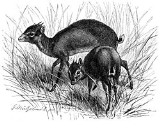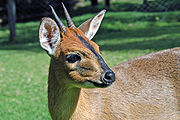
Duiker
Encyclopedia
A duiker is any of about 21 small to medium-sized antelope
species
from the subfamily Cephalophinae native to Sub-Saharan Africa
.
 Duikers are shy and elusive creatures with a fondness for dense cover; most are forest dwellers and even the species living in more open areas are quick to disappear into thickets. Their name comes from the Afrikaans
Duikers are shy and elusive creatures with a fondness for dense cover; most are forest dwellers and even the species living in more open areas are quick to disappear into thickets. Their name comes from the Afrikaans
/Dutch
word for diver and refers to their practice of diving into tangles of shrubbery
.
With a slightly arched body and the front legs a little shorter than the hind legs, they are well-shaped to penetrate thickets. They are primarily browsers
rather than grazers
, eating leaves, shoots, seeds, fruit, buds and bark, and often follow flocks of birds or troops of monkeys to take advantage of the fruit they drop. They supplement their diet with meat: duikers take insects and carrion from time to time, and even stalk and capture rodents or small birds. The Blue Duiker has a fondness for ant
s.
Antelope
Antelope is a term referring to many even-toed ungulate species indigenous to various regions in Africa and Eurasia. Antelopes comprise a miscellaneous group within the family Bovidae, encompassing those old-world species that are neither cattle, sheep, buffalo, bison, nor goats...
species
Species
In biology, a species is one of the basic units of biological classification and a taxonomic rank. A species is often defined as a group of organisms capable of interbreeding and producing fertile offspring. While in many cases this definition is adequate, more precise or differing measures are...
from the subfamily Cephalophinae native to Sub-Saharan Africa
Sub-Saharan Africa
Sub-Saharan Africa as a geographical term refers to the area of the African continent which lies south of the Sahara. A political definition of Sub-Saharan Africa, instead, covers all African countries which are fully or partially located south of the Sahara...
.

Afrikaans
Afrikaans is a West Germanic language, spoken natively in South Africa and Namibia. It is a daughter language of Dutch, originating in its 17th century dialects, collectively referred to as Cape Dutch .Afrikaans is a daughter language of Dutch; see , , , , , .Afrikaans was historically called Cape...
/Dutch
Dutch language
Dutch is a West Germanic language and the native language of the majority of the population of the Netherlands, Belgium, and Suriname, the three member states of the Dutch Language Union. Most speakers live in the European Union, where it is a first language for about 23 million and a second...
word for diver and refers to their practice of diving into tangles of shrubbery
Shrubbery
A shrubbery is a wide border to a garden where shrubs are thickly planted; or a similar larger area with a path winding through it. A shrubbery was a feature of 19th-century gardens in the English manner, with its origins in the gardenesque style of the early part of the century...
.
With a slightly arched body and the front legs a little shorter than the hind legs, they are well-shaped to penetrate thickets. They are primarily browsers
Browsing (predation)
Browsing is a type of herbivory in which an herbivore feeds on leaves, soft shoots, or fruits of high growing, generally woody, plants such as shrubs. This is contrasted with grazing, usually associated with animals feeding on grass or other low vegetation...
rather than grazers
Grazing
Grazing generally describes a type of feeding, in which a herbivore feeds on plants , and also on other multicellular autotrophs...
, eating leaves, shoots, seeds, fruit, buds and bark, and often follow flocks of birds or troops of monkeys to take advantage of the fruit they drop. They supplement their diet with meat: duikers take insects and carrion from time to time, and even stalk and capture rodents or small birds. The Blue Duiker has a fondness for ant
Ant
Ants are social insects of the family Formicidae and, along with the related wasps and bees, belong to the order Hymenoptera. Ants evolved from wasp-like ancestors in the mid-Cretaceous period between 110 and 130 million years ago and diversified after the rise of flowering plants. More than...
s.
Species
-
- Subfamily Cephalophinae
- Genus Cephalophus
- Abbott's DuikerAbbott's DuikerAbbott's Duiker is a large forest dwelling Duiker found only in a couple of scattered enclaves in Tanzania. It is believed by some to be a subspecies of the Yellow-backed Duiker...
, Cephalophus spadix - Ader's DuikerAder's DuikerThe Aders' Duiker , also known as Nunga in Swahili, Kunga marara in Kipokomo, and Harake in Giriama), is a small forest dwelling Duiker found only on Zanzibar and in a small coastal enclave in Kenya. It is also critically endangered...
, Cephalophus adersi - Bay DuikerBay DuikerThe Bay Duiker is a forest dwelling Duiker found in Gabon, southern Cameroon and northern Congo as well as Sierra Leone, Liberia, and the southern parts of Côte d'Ivoire, Ghana and Benin...
, Cephalophus dorsalis - Black DuikerBlack DuikerBlack duiker is a forest dwelling duiker found in the southern parts of Sierra Leone, Liberia, Côte d'Ivoire, Ghana, Benin and Nigeria....
, Cephalophus niger - Black-fronted DuikerBlack-fronted DuikerThe Black-fronted Duiker , is a small antelope found in central and west-central Africa. It averages and a shoulder height of . It has been found as far south as northern Angola.-External links:*wildaboutyou.com -...
, Cephalophus nigrifrons - Brooke's DuikerBrooke's DuikerBrooke's Duiker , is a species of antelope. It is distributed throughout Liberia, Sierra Leone and Côte d'Ivoire....
, Cephalophus brookei - Harvey's DuikerHarvey's DuikerHarvey's Red Duiker is one of 19 species of duiker found in Tanzania and scattered through Kenya, southern Somalia, and, possibly, central Ethiopia....
, Cephalophus harveyi
- Jentink's DuikerJentink's DuikerJentink's Duiker, Cephalophus jentinki, also known as Gidi-Gidi in Krio and Kaikulowulei in Mende, is a forest-dwelling duiker found in the southern parts of Liberia, south-western Côte d'Ivoire, and scattered enclaves in Sierra Leone...
, Cephalophus jentinki - Ogilby's DuikerOgilby's DuikerOgilby's Duiker , is a small antelope found in Sierra Leone, Liberia, Ghana, southeastern Nigeria, Equatorial Guinea's Bioko Island, and, possibly, Gabon...
, Cephalophus ogilbyi - Peters's DuikerPeters's DuikerPeter's Duiker , is a small antelope found in Gabon, Equatorial Guinea, southern Cameroon and northern Republic of Congo....
, Cephalophus callipygus - Red-flanked DuikerRed-flanked DuikerThe Red-flanked Duiker , is a tiny antelope found in western and central Africa.Red-flanked Duikers grow to almost 15 inches in height and weigh up to 31 pounds...
, Cephalophus rufilatus - Red Forest DuikerRed Forest DuikerThe Red Forest Duiker, Natal Duiker, or Natal Red Duiker , is a small antelope found in central to southern Africa. It is found in forests and shrublands in Malawi, Mozambique, and southern Tanzania....
, Cephalophus natalensis - Ruwenzori DuikerRuwenzori DuikerThe Ruwenzori Duiker or Ruwenzori Red Duiker , is a stocky but small antelope found only in the Ruwenzori Mountains between Uganda and, probably, Democratic Republic of Congo. They may be a sub-species of the Black-fronted Duiker or the Red-flanked Duiker.The Ruwenzori Duiker weighs about 15...
, Cephalophus rubidis - Weyns's DuikerWeyns's DuikerWeyns Duiker , is a tiny antelope found in the Democratic Republic of Congo, Uganda, and western Kenya. It is sometimes spelled "Weyn's", or as "Weyns' Duiker"....
, Cephalophus weynsi - White-bellied DuikerWhite-bellied DuikerThe White-bellied Duiker is a duiker found in central Africa. Little is known on the ecology of the species, and only some information on habitat and diet is available....
, Cephalophus leucogaster - Yellow-backed DuikerYellow-backed DuikerThe Yellow-backed Duiker , is an antelope found in central and western Africa. They have the widest range of any duiker in the genus Cephalophus....
, Cephalophus silvicultor - Zebra DuikerZebra DuikerThe Zebra Duiker is a small antelope found in Ivory Coast, Guinea, Sierra Leone and Liberia.Zebra Duikers have gold or red-brown coats with distinctive zebra-like stripes, dark markings on their upper legs and russet faces. They grow to 90 centimetres in length, 45 centimetres in height and weigh...
, Cephalophus zebra
- Abbott's Duiker
- Genus Philantomba
- Blue DuikerBlue DuikerBlue Duiker is a small forest dwelling duiker found in the Central Africa and southern South Africa.Blue Duikers stand around 35 centimetres tall at the shoulder and weigh 4 kilograms.They are the smallest of the antelope family. Blue Duikers have a brown coat with a slight blue tinge – hence...
, Philantomba monticola - Maxwell's DuikerMaxwell's DuikerMaxwell's Duiker , is a small antelope found in western Africa.They grow to 30 inches in length with a typical shoulder height of 14.5–16 inches and weigh around 11 pounds . Its coat is either grey-brown or grey, with a white underbelly and white markings on its face...
, Philantomba maxwellii - Walter's DuikerWalter's duikerWalter's duiker is a species of duiker found in Togo, Benin and Nigeria. It measures under tall at the shoulder, and weighs between 4 and 6 kilograms. It was described in 2010 following comparison of specimens in museum collections with those from bushmeat markets...
, Philantomba walteri
- Blue Duiker
- Genus Sylvicapra
- Common DuikerCommon DuikerThe Common Duiker, Sylvicapra grimmia, also known as the Grey or Bush Duiker, is a small antelope with small horns found in west, central, east, and southern Africa- essentially everywhere in Africa south of the Sahara, excluding the horn of Africa and the rainforests of the central and western...
, Sylvicapra grimmia
- Common Duiker
- Genus Cephalophus
- Subfamily Cephalophinae

